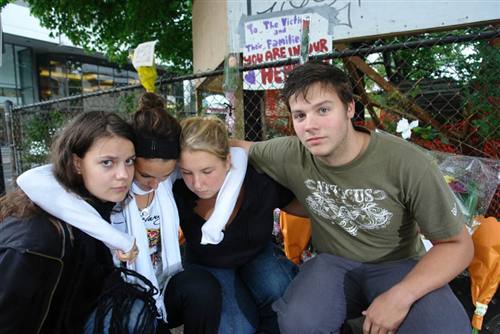Dawson College Shootings: The Experience of Two Emergency Workers

Article and photos by Guy Labissonnière, journalist
On Wednesday, September 13, 2006, Jean-Marie Dufresne and his co-worker Patrice Grenier were giving a first-aid and CPR course to employees at the Collège des médecins. They were eating lunch at Plaza Alexis-Nihon, just across the street from Dawson College, when they saw a stream of students running to safety in the shopping mall. Thinking they could help, they ran to the scene, where they quickly came upon two people who had been shot and were lying on the sidewalk.
Two uniformed police officers, already present at the scene for a separate incident, rushed into the college. A plain-clothes police officer protected the emergency workers while they gave first aid to the two wounded people. One was a man with a bloody head injury, the other a woman who had been shot in the pelvis.
Only about ten minutes after they arrived, stretchers were brought to evacuate the victims. The evacuation was carried out by police officers, as ambulance attendants are not allowed to enter crime scenes that have not yet been secured.
But Jean-Marie Dufresne and Patrice Grenier were not finished yet. Jean-Marie was still needed to staunch the head trauma victim’s severe bleeding until he was transferred to the ambulance attendants. Patrice went right back to work, giving first aid to two other victims who had been evacuated from the college by friends.
Mr. Dufresne is an ambulance attendant and paramedic. At the time of the shootings, he was on parental leave, the proud father of a three-week-old girl. Mr. Grenier is a first responder, an emergency worker who is dispatched to remote locations when the ambulance services would take much longer to arrive.
*
This article is not intended to shock or amaze you like a reality TV show. Its purpose is to help you understand what it’s like for people who save lives as good Samaritans, often at the price of their own emotional health. For most of us, the Dawson school rampage will soon be only a bad memory, but what about for these volunteers, who work in the shadows? What kind of support does society provide for those who help out when needed? Even soldiers who return from the front with shattered souls are sometimes forced to beg for the help they need. What is the situation for volunteers? What if they experience psychological trauma, which in some cases only manifests itself a while after the events?
Photos by Guy Labissonnière.
English translation: Christine York

This article is part of a series on the diversity of values and religious beliefs in colleges and universities and is presented with the financial support of:
 *
* Dawson College students. Sarah Teman, age 18, a student in social science, Kate Shumskaya, age 18, a student in interior design, Samantha Tauby, age 17, a student in cinema and communications and Jeremy Murray, age 18, a student in social science.
The students were placing floral tributes and lighting candles in honour of one of their friends, injured in the shootings. Jeremy, who was very close to the shooting, heard bursts of gunfire that lasted, according to his perception of time, at least 30 seconds. He saw one of his friends, shot in the stomach, being transported out of the school.
** Jean-Marie Dufresne, ambulance attendant and paramedic.
*** A group of Dawson students who came to leave floral tributes in memory of their personal friend, killed in the shootings.